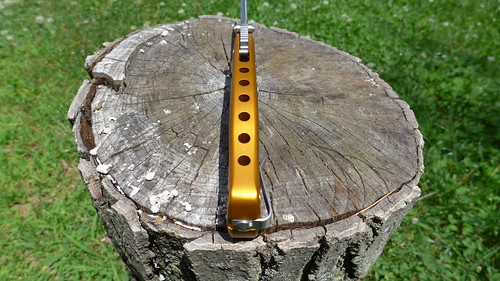Lionsteel SR-1a Review
The SR-1a is the Monica Bellucci of folding knives--curvy, stunningly beautiful, and utterly Italian. It is a working sculpture and an statement of Lionsteel's impressive technical capacities. But unlike a few of the modern marvels we have been treated to recently, a list of which includes the ZT 0777 and 0888, the Benchmade Dual Action Sibert, and the CRKT Hi Jinx, the SR-1a, it is imminently affordable. Andrew has harped on this point for a while now on the podcast and the more he says it the more I think he is right--part of good design is affordability. And while no one will mistake the SR-1a for a budget knife, given what you get, its price tag is crazy low. It, like a few other blades and lights, is yet another sign that we are living in the Golden Age of Gear.
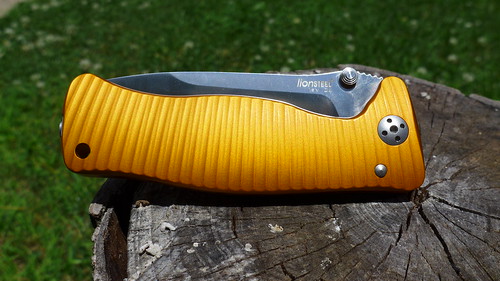
At this point it is probably worth mentioning the aluminum handle. I think the choice of aluminum was brilliant. Normally aluminum is too soft to work in a framelock as the steel is so much harder and over time it will compress the lockbar and the lock up will not be as tight. As such, titanium, which is still much softer than blade steels, is preferred. But titanium is both heavier and more expensive than aluminum. Lionsteel solved this problem by including a lock face insert made of stainless steel. That not only prevents the compression problem, it also allows you to swap out the lock face when it wears in too much (where you get all of these replacement lock faces, I have no idea, especially if Lionsteel, God forbid, goes out of business). Overall, I like titanium more, but in this role, aluminum works fine, especially with Lionsteel's very clever design.
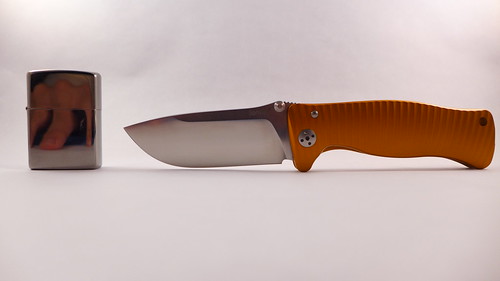
Here is the product page. The SR-1a as reviewed here cost $209.95. There are a few variants. First there is the SR-1, which is the original knife in this series and it had an integral Ti handle. It came in a few different steels. Then there is the SR-2, which is a smaller version of the knife, with a blade length right at 3 inches. That knife also came in an aluminum version, the SR-2a. There were a variety of steels there as well. Though not technically in the same series, Lionsteel has lumped the SR series with its two other integrals, the TiSpine and the TM series. Finally, Lionsteel did a Spyderco-ized version of the SR series called the LionSpy. It comes in both the small and the large size. The large is one of the most expensive Spydercos ever made, yet it does not have the integral handle, meaning that it is kind of like a sports car without the powerful engine. Here is a review of the SR-1a in video form and here is one in writing. Here is a link to Blade HQ, where you can find the Lionsteel SR-1a, and all proceeds benefit the site when you purchase things through this link:
Blade HQ
Blade HQ
Here is my review sample (sent to me by BladeHQ and already returned):

Finally, here is my video overview of the knife:
Twitter Review Summary: A technical marvel with an ergonomic snafu.
Design: 2
Its hard not to be impressed with the SR-1a. When it slid out of the box and into my hand for the first time I was a bit taken aback. This was my first integral and I had for a long time though that integrals were more showing off than anything else. But when I slow rolled the thumb stud and the knife clicked open I knew I was wrong. The rigidity the integral design gives the knife is like nothing else. It probably doesn't make a difference during use, but it is undeniable that the integral design locks everything in place in a way that a constructed handle doesn't. Even the ping of the lockbar sounds different. People that buy Sub Zero fridges often babble on about how the door sounds when it closes (in my previous life I was an installer of high end A/V stuff and saw many a Sub Zero fridge). The sound of the lockbar popping into place on the SR-1a is the same thing--cool, distinctive, but probably not all that big a deal.
At this point it is probably worth mentioning the aluminum handle. I think the choice of aluminum was brilliant. Normally aluminum is too soft to work in a framelock as the steel is so much harder and over time it will compress the lockbar and the lock up will not be as tight. As such, titanium, which is still much softer than blade steels, is preferred. But titanium is both heavier and more expensive than aluminum. Lionsteel solved this problem by including a lock face insert made of stainless steel. That not only prevents the compression problem, it also allows you to swap out the lock face when it wears in too much (where you get all of these replacement lock faces, I have no idea, especially if Lionsteel, God forbid, goes out of business). Overall, I like titanium more, but in this role, aluminum works fine, especially with Lionsteel's very clever design.
The performance ratios are meh. Here is the SR-1a next to the Zippo as a size comparison:

The blade:handle is .80. The blade:weight is .66. The blade:handle is quite good, but the blade:weight is well, portly. This is, even with all of the design feats and engineering tricks, a big, fat knife.
Fit and Finish: 2
Fit and Finish: 2
Simply put Lionsteel's manufacturing and fit and finish is the best in the knife business right now. No one, not KAI, not Spyderco, and not Benchmade, are as consistently innovative and meticulous as Lionsteel. They got their chops as an OEM, making knives for other folks, and they did a great job. But their own stuff is superb and the SR-1a is no exception. There were no flaws, not stray machining marks (even on the inside of the knife where the channel for the blade was hollowed out). The blade sat dead center and it too was gloriously finished. They even took time, on this cheaper model, to round over the spine of the blade. All in all, the SR-1a is a testament to just how good Lionsteel is right now. They are amazing and so is this knife.
Grip: 1
The handle's shape is quite nice with a good cut for your index finger, a nice palm swell, and a mild parrot's beak at the end of the handle to lock your hand in place. The overall size and shape was very comfortable.
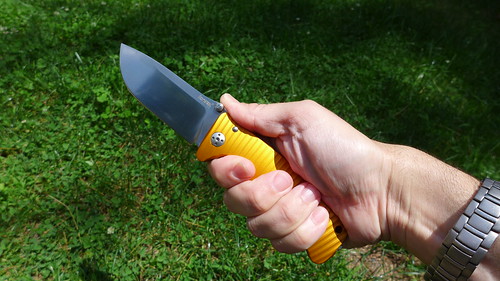
So why the 1? This is putatively a hard use folder--the lock says so, the Rotoblock says so, the size says so, and the product literature says so. But when I used the knife in chopping tasks I could help but have the knife move around on me. The handles themselves are so smooth and slick. The machining, those subtle and beautiful grooves, just did nothing to keep things in place. So I am not sure if this is the Cadillac Escalade of folders--something that is so blinged out that its origins as a hard use device are forgotten. But for the very nice handle shape (quite reminiscent of the classic Becker handle shape seen on his line of fixed blades), this would have a been a complete failure. As it, both the shape and the minimal but well cut jimping put this in the average camp. Compared to something like the PM2, there is no question which knife comes out ahead.
Carry: 2
Its slim, smooth, and not too wide (though getting close). As such, it carries as well as anything that has the same size and weight. This thing is THIN:

I really liked how thin it was when I was carrying it in my pocket. That plus, the wonderfully fussed-over edges, all of which have been chamfered or rounded over, make this a great knife in the pocket despite is very heavy weight.
Steel: 2

So why the 1? This is putatively a hard use folder--the lock says so, the Rotoblock says so, the size says so, and the product literature says so. But when I used the knife in chopping tasks I could help but have the knife move around on me. The handles themselves are so smooth and slick. The machining, those subtle and beautiful grooves, just did nothing to keep things in place. So I am not sure if this is the Cadillac Escalade of folders--something that is so blinged out that its origins as a hard use device are forgotten. But for the very nice handle shape (quite reminiscent of the classic Becker handle shape seen on his line of fixed blades), this would have a been a complete failure. As it, both the shape and the minimal but well cut jimping put this in the average camp. Compared to something like the PM2, there is no question which knife comes out ahead.
Carry: 2
Its slim, smooth, and not too wide (though getting close). As such, it carries as well as anything that has the same size and weight. This thing is THIN:

I really liked how thin it was when I was carrying it in my pocket. That plus, the wonderfully fussed-over edges, all of which have been chamfered or rounded over, make this a great knife in the pocket despite is very heavy weight.
Steel: 2
This model came with D2 steel and D2 is, has been, and just might always will be a great steel. Its hard. Its tough. Its rust resistant enough to get by. There is just not a lot of bitch about with D2. Well, okay it is hard to sharpen, but in my testing I didn't have reason to do more than strop it and it was fine. The knife did well cutting wood for fires, horsing around in the woods, and with EDC tasks. Its kinda boring to write about D2 because so many people have experience with it, but its also hard to avoid the fact that even now, many years later D2 is still one hell of a performer.
Blade Shape: 2
Who doesn't love a good drop point? The most useful and generalized of blade shapes just about always works for a given tasks, even if something else does it better. Here, the belly of the knife is almost comically exaggerated:
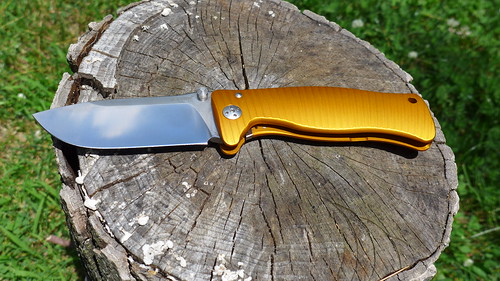
I liked this bold shape a good deal and the front sharpened edge was big enough to do push cuts with like the Spyderco Zulu or what I imagine one could do with a Jon Graham style knife. Very beautiful, very bold, very curvy blade shape (hence the Monica Belluci analogy).
Grind: 2
As you can see from about the grind here is meticulous. It is a high hollow grind, starting about 1/5 of the way down the knife. This, combined with the width of the blade gives you a very, very slim edge. Despite the overall massively thick stock, the SR-1a is still a pretty impressive slicer and the wonderful grind is why. Also, as you can see, it is clean and without wandering or unevenness. Lionsteel's technical prowess cannot be questioned.
Deployment Method: 0
And here we are--the one flaw with the knife. The deployment method suffered on a number of accounts. First, the placement of the studs at the very edge of the knife can make it difficult to span the width of the blade to get to them. Folks with small hands will have a time reaching them because this is a wide knife. Hobbits, this isn't your EDC (Bilbo, I think Sting had better steel anyway...this won't glow around orcs). Second, even if you have medium sized hands or larger, given how far away the studs are, it is hard to generate a lot of force. Popping this knife open quickly, as opposed to a slow roll, is a challenge. It can be done, but it requires a lot of practice and focus. Third and finally, there is really not enough to hold on to here. The thin, curvy, smooth handle doesn't give your non-thumb digits a place to rest when opening the knife.
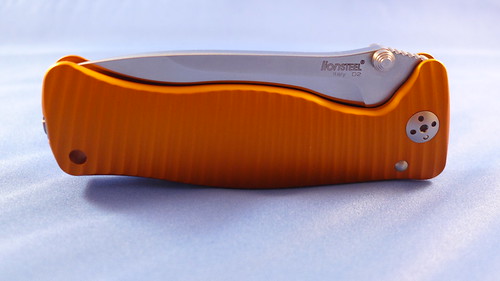
The end result is one of the more challenging to open knives I have used. It works, but just barely. A thumb plate would have worked wonders and really, a flipper would be ideal. I can't speak to a thumb hole as I have not yet held the Lionspy or its little brother, but I can't imagine it would be worse.
Retention Method: 2
I love the simple, small, and effective clip on the SR-1a.
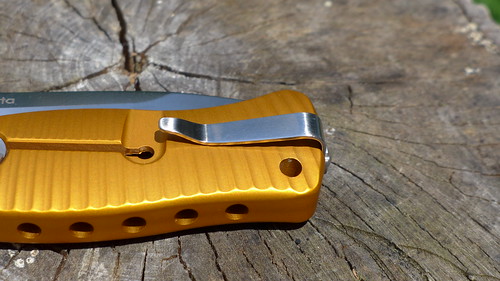
The fact that it can be switched to the other side easily and it is an over-the-top style clip makes it all the better. It bears more than a passing resemblance to another clip I loved--the Buck Vantage clip and I can't complain here. It works well.
Lock: 2
The lock here is really nice, but the Rotoblock was a big fat meh. This is my second knife review of a knife with the Rotoblock and while it is nice and it works, it is a bit gimmicky. Its sort of like a spoiler on a sedan--sure it might make a bit of difference in performance but the difference is so small it is meaningless in the real world. There were never any instances in which I thought: "Man I really need this Rotoblock lock." That said, it didn't hinder operation at all and so it is a different kind of gimmicky from, say, the AutoLAWKS found on the CRKT M16. The lock itself was vault tight, easy to engage and disengage, and wonderfully stable when in place.
Overall Score: 17 out of 20
For the money there is nothing out there with the gee whiz factor of the SR-1a. The idea that you can buy an integral framelock with this level of fit and finish for just over $200 is staggering. It is easily one of the three or four most impressive values on the market. But the deployment was slow. I can't seem to get over that. Slow rolling the blade open is basically all you can do without some focus or practice. I don't think that is a killing problem, but it is annoying. Even with that, this is superb blade. It is a little blingy for my tasks, but its certainly not over the top. Well, okay, maybe the orange version is over the top. But all of the other colors are nice. Blingy, but not insane.
The Competition
Comparing the SR-1a to the SOG Mini Aegis is very difficult. They are totally different kinds of tools. That said, both are excellent values, and the scores being the same makes me happy in a way. Obviously they are different prices, but I like the fact that flawed but great knives score the same, even if made by different companies with different design choices and methods of production. They are different and not really comparable, but both are great values.
Blade Shape: 2
Who doesn't love a good drop point? The most useful and generalized of blade shapes just about always works for a given tasks, even if something else does it better. Here, the belly of the knife is almost comically exaggerated:

I liked this bold shape a good deal and the front sharpened edge was big enough to do push cuts with like the Spyderco Zulu or what I imagine one could do with a Jon Graham style knife. Very beautiful, very bold, very curvy blade shape (hence the Monica Belluci analogy).
Grind: 2
As you can see from about the grind here is meticulous. It is a high hollow grind, starting about 1/5 of the way down the knife. This, combined with the width of the blade gives you a very, very slim edge. Despite the overall massively thick stock, the SR-1a is still a pretty impressive slicer and the wonderful grind is why. Also, as you can see, it is clean and without wandering or unevenness. Lionsteel's technical prowess cannot be questioned.
Deployment Method: 0
And here we are--the one flaw with the knife. The deployment method suffered on a number of accounts. First, the placement of the studs at the very edge of the knife can make it difficult to span the width of the blade to get to them. Folks with small hands will have a time reaching them because this is a wide knife. Hobbits, this isn't your EDC (Bilbo, I think Sting had better steel anyway...this won't glow around orcs). Second, even if you have medium sized hands or larger, given how far away the studs are, it is hard to generate a lot of force. Popping this knife open quickly, as opposed to a slow roll, is a challenge. It can be done, but it requires a lot of practice and focus. Third and finally, there is really not enough to hold on to here. The thin, curvy, smooth handle doesn't give your non-thumb digits a place to rest when opening the knife.

The end result is one of the more challenging to open knives I have used. It works, but just barely. A thumb plate would have worked wonders and really, a flipper would be ideal. I can't speak to a thumb hole as I have not yet held the Lionspy or its little brother, but I can't imagine it would be worse.
Retention Method: 2
I love the simple, small, and effective clip on the SR-1a.

The fact that it can be switched to the other side easily and it is an over-the-top style clip makes it all the better. It bears more than a passing resemblance to another clip I loved--the Buck Vantage clip and I can't complain here. It works well.
Lock: 2
The lock here is really nice, but the Rotoblock was a big fat meh. This is my second knife review of a knife with the Rotoblock and while it is nice and it works, it is a bit gimmicky. Its sort of like a spoiler on a sedan--sure it might make a bit of difference in performance but the difference is so small it is meaningless in the real world. There were never any instances in which I thought: "Man I really need this Rotoblock lock." That said, it didn't hinder operation at all and so it is a different kind of gimmicky from, say, the AutoLAWKS found on the CRKT M16. The lock itself was vault tight, easy to engage and disengage, and wonderfully stable when in place.
Overall Score: 17 out of 20
For the money there is nothing out there with the gee whiz factor of the SR-1a. The idea that you can buy an integral framelock with this level of fit and finish for just over $200 is staggering. It is easily one of the three or four most impressive values on the market. But the deployment was slow. I can't seem to get over that. Slow rolling the blade open is basically all you can do without some focus or practice. I don't think that is a killing problem, but it is annoying. Even with that, this is superb blade. It is a little blingy for my tasks, but its certainly not over the top. Well, okay, maybe the orange version is over the top. But all of the other colors are nice. Blingy, but not insane.
The Competition
Comparing the SR-1a to the SOG Mini Aegis is very difficult. They are totally different kinds of tools. That said, both are excellent values, and the scores being the same makes me happy in a way. Obviously they are different prices, but I like the fact that flawed but great knives score the same, even if made by different companies with different design choices and methods of production. They are different and not really comparable, but both are great values.

